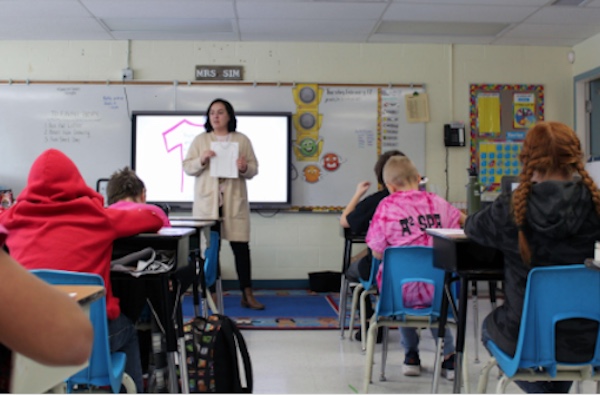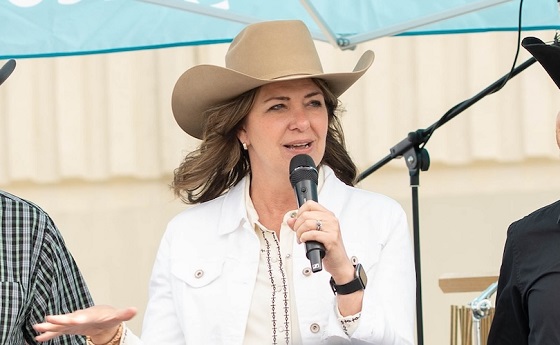Alberta
First year teacher from Aspen Heights Elementary up for provincial award

Building relationships key to successful first year Teacher Tosha Sim
Tosha, a first year teacher at Aspen Heights Elementary, has been named Red Deer Public’s nominee for the prestigious Edwin Parr Teacher Award.
Each year the Alberta School Boards Association honours six outstanding first-year teachers with the Edwin Parr Teacher Award. School boards may nominate any first-year Kindergarten to Grade 12 teacher who has taught in an Alberta school jurisdiction which is a member of the ASBA.
Rob Moltzahn, Associate Superintendent of Human Resources for Red Deer Public, said Tosha was chosen as this year’s nominee because she is a reflective and creative teacher whose students are enthusiastically engaged in the classroom.
“Red Deer Public has fantastic teachers from our first years to our veterans, allowing students to benefit from this wealth and depth of knowledge,” he said. “Tosha is clearly passionate about teaching. Her interaction and connection with students was remarkable to see. Tosha took care of the needs of all students in her class without missing a beat.”
For Tosha, she said the nomination took her by surprise.
“The special part was that my principal, Bill Kwasny, said in his whole career that he’s never nominated a first year teacher before. It was really cool,” she said.
Tosha has had a lifelong dream of becoming a teacher, and remembers Career Days in elementary school where she would dress up as a teacher.
“I truly love everything about being a teacher. There isn’t a day where I don’t want to get up and come to work,” said Tosha, who currently teaches a Grade 4/5 combined class. “It’s incredible to be part of each of my students’ lives at this time in their life and help mold them into the beautiful people they will be. It’s amazing – I can’t imagine not teaching.”
Growing up, relationships with teachers were an integral part of Tosha’s school years, and played a significant role in her decision to pursue teaching as a career.
“I can name off every single teacher in my life, and there are some that have been so special,” she said. “Being taught by phenomenal teachers has given me a solid platform as I begin my career and I’m very grateful for that.”
Since being in her classroom since last fall, Tosha said seeing her students learn and grow has been extremely fulfilling.
“It’s been amazing to see where they are now compared to where they were in the fall. Their growth in learning has been incredible to see.”
Last July, Tosha taught at Reading College, a program of the Foundation for Red Deer Public Schools, which helps Grade 2 students who are struggling readers become readers of potential. It was an experience she will never forget, and will always be grateful for.
“I will sing Reading College’s praises for my whole life,” she said. “It was an incredible experience. I think the biggest part was learning how to build those relationships in those four weeks – it really helped me in my classroom now. And helping kids develop a love of reading will play a part in the rest of my career as well!”
Bill Kwasny, Principal at Aspen Heights Elementary School, said Tosha has been an excellent addition to Aspen Heights Elementary.
“She has built a classroom that is caring, inclusive and safe,” he said. “Her students know that she cares deeply for them and she respects and values their differences.Her students have celebrated her nomination and feel pride that they are responsible, in part, for her success. Tosha’s passion for teaching is apparent for the time you first step foot in her classroom. It is a pleasure having the opportunity to work with Tosha.”
Alberta
Danielle Smith slams Skate Canada for stopping events in Alberta over ban on men in women’s sports

From LifeSiteNews
The Alberta premier has denounced Skate Canada as ‘disgraceful’ for refusing to host events in the province because of a ban on ‘transgender’ men in women’s sports.
Alberta Premier Danielle Smith has demanded an apology after Skate Canada refused to continue holding events in Alberta.
In a December 16 post on X, Smith denounced Skate Canada’s recent decision to stop holding competitions in Alberta due to a provincial law keeping gender-confused men from competing in women’s sports.
“Women and girls have the right to play competitive sports in a safe and fair environment against other biological females,” Smith declared. “This view is held by a vast majority of Albertans and Canadians. It is also common sense and common decency.”
Women and girls have the right to play competitive sports in a safe and fair environment against other biological females.
This view is held by a vast majority of Albertans and Canadians. It is also common sense and common decency.
Skate Canada‘s refusal to hold events in… pic.twitter.com/n4vbkTx6B0
— Danielle Smith (@ABDanielleSmith) December 16, 2025
“Skate Canada‘s refusal to hold events in Alberta because we choose to protect women and girls in sport is disgraceful,” she declared.
“We expect they will apologize and adjust their policies once they realize they are not only compromising the fairness and safety of their athletes, but are also offside with the international community, including the International Olympic Committee, which is moving in the same direction as Alberta,” Smith continued.
Earlier this week, Skate Canada announced their decision in a statement to CBC News, saying, “Following a careful assessment of Alberta’s Fairness and Safety in Sport Act, Skate Canada has determined that we are unable to host events in the province while maintaining our national standards for safe and inclusive sport.”
Under Alberta’s Fairness and Safety in Sport Act, passed last December, biological men who claim to be women are prevented from competing in women’s sports.
Notably, Skate Canada’s statement failed to address safety and fairness concerns for women who are forced to compete against stronger, and sometimes violent, male competitors who claim to be women.
Under their 2023 policy, Skate Canada states “skaters in domestic events sanctioned by Skate Canada who identify as trans are able to participate in the gender category in which they identify.”
While Skate Canada maintains that gender-confused men should compete against women, the International Olympic Committee is reportedly moving to ban gender-confused men from women’s Olympic sports.
The move comes after studies have repeatedly revealed what almost everyone already knew was true, namely that males have a considerable innate advantage over women in athletics.
Indeed, a recent study published in Sports Medicine found that a year of “transgender” hormone drugs results in “very modest changes” in the inherent strength advantages of men.
Additionally, male athletes competing in women’s sports are known to be violent, especially toward female athletes who oppose their dominance in women’s sports.
Last August, Albertan male powerlifter “Anne” Andres was suspended for six months after a slew of death threats and harassments against his female competitors.
In February, Andres ranted about why men should be able to compete in women’s competitions, calling for “the Ontario lifter” who opposes this, apparently referring to powerlifter April Hutchinson, to “die painfully.”
Interestingly, while Andres was suspended for six months for issuing death threats, Hutchinson was suspended for two years after publicly condemning him for stealing victories from women and then mocking his female competitors on social media. Her suspension was later reduced to a year.
Alberta
Alberta’s huge oil sands reserves dwarf U.S. shale

From the Canadian Energy Centre
By Will Gibson
Oil sands could maintain current production rates for more than 140 years
Investor interest in Canadian oil producers, primarily in the Alberta oil sands, has picked up, and not only because of expanded export capacity from the Trans Mountain pipeline.
Enverus Intelligence Research says the real draw — and a major factor behind oil sands equities outperforming U.S. peers by about 40 per cent since January 2024 — is the resource Trans Mountain helps unlock.
Alberta’s oil sands contain 167 billion barrels of reserves, nearly four times the volume in the United States.
Today’s oil sands operators hold more than twice the available high-quality resources compared to U.S. shale producers, Enverus reports.
“It’s a huge number — 167 billion barrels — when Alberta only produces about three million barrels a day right now,” said Mike Verney, executive vice-president at McDaniel & Associates, which earlier this year updated the province’s oil and gas reserves on behalf of the Alberta Energy Regulator.
Already fourth in the world, the assessment found Alberta’s oil reserves increased by seven billion barrels.
Verney said the rise in reserves despite record production is in part a result of improved processes and technology.
“Oil sands companies can produce for decades at the same economic threshold as they do today. That’s a great place to be,” said Michael Berger, a senior analyst with Enverus.
BMO Capital Markets estimates that Alberta’s oil sands reserves could maintain current production rates for more than 140 years.
The long-term picture looks different south of the border.
The U.S. Energy Information Administration projects that American production will peak before 2030 and enter a long period of decline.
Having a lasting stable source of supply is important as world oil demand is expected to remain strong for decades to come.
This is particularly true in Asia, the target market for oil exports off Canada’s West Coast.
The International Energy Agency (IEA) projects oil demand in the Asia-Pacific region will go from 35 million barrels per day in 2024 to 41 million barrels per day in 2050.
The growing appeal of Alberta oil in Asian markets shows up not only in expanded Trans Mountain shipments, but also in Canadian crude being “re-exported” from U.S. Gulf Coast terminals.
According to RBN Energy, Asian buyers – primarily in China – are now the main non-U.S. buyers from Trans Mountain, while India dominates purchases of re-exports from the U.S. Gulf Coast. .
BMO said the oil sands offers advantages both in steady supply and lower overall environmental impacts.
“Not only is the resulting stability ideally suited to backfill anticipated declines in world oil supply, but the long-term physical footprint may also be meaningfully lower given large-scale concentrated emissions, high water recycling rates and low well declines,” BMO analysts said.
-

 Alberta2 days ago
Alberta2 days agoAlberta’s huge oil sands reserves dwarf U.S. shale
-

 Indigenous2 days ago
Indigenous2 days agoResidential school burials controversy continues to fuel wave of church arsons, new data suggests
-

 Health2 days ago
Health2 days agoCanadian gov’t considers sharing census data on gender-confused children
-

 Health2 days ago
Health2 days agoSaskatchewan woman approved for euthanasia urged to seek medical help in Canada rather than US
-

 Daily Caller2 days ago
Daily Caller2 days agoParis Climate Deal Now Decade-Old Disaster
-

 Business1 day ago
Business1 day agoOttawa Pretends To Pivot But Keeps Spending Like Trudeau
-

 International2 days ago
International2 days agoFBI didn’t think it had cause to raid Trump but DOJ did it anyway
-

 International1 day ago
International1 day agoBondi Beach Shows Why Self-Defense Is a Vital Right






